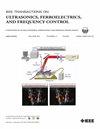A Novel 2x2D Radial Basis Function-Based Interpolation for Short Acquisition Time and Relaxed Frame Rate Ultrasound Localization Microscopy
IF 3.7
2区 工程技术
Q1 ACOUSTICS
IEEE transactions on ultrasonics, ferroelectrics, and frequency control
Pub Date : 2024-12-11
DOI:10.1109/TUFFC.2024.3515218
引用次数: 0
Abstract
Ultrasound localization microscopy (ULM) has become a potent technique for microvascular imaging using ultrasound waves. However, one major challenge is the high frame rate and lengthy acquisition time needed to produce super-resolved (SR) images. To overcome this, our goal is to relax the frame rate and shorten this acquisition time while preserving SR image quality, thereby enhancing ULM’s clinical applicability. To this end, we propose two distinct strategies: first, we suggest acquiring the data at lower frame rate followed by applying the reconstruction technique to compensate the lost information due to low frame rate imaging. Second, to tackle the prolonged acquisition time, we propose compressing acquisition time by a compression ratio (CR), which can degrade SR image quality due to reduced temporal information. To mitigate this, we temporally upsample the in-phase-quadrature (IQ) data by a factor equal to the CR after compressed acquisition. In addition, we introduce a novel bidirectional (2x2D) interpolation (IP) using radial basis function (RBF)-based reconstruction to estimate unknown values in the 3D IQ data (x–z–t), thereby enhancing temporal resolution. The rationale behind using 2x2D IP is its ability to integrate spatiotemporal information from two orthogonal x–t and z–t planes, effectively addressing anisotropies and nonuniformities in microbubble motion. This 2x2D approach improves the reconstruction of microbubbles’ dynamics by interpolating along both the x- and z-directions. The method was tested on rat brain and rat kidney datasets recorded at 1 kHz, demonstrating relaxing the frame rate to 100 Hz (using the first strategy) and a reduction in acquisition time by a factor of 3 to 4 (using the second strategy) while maintaining SR image quality comparable to the original uncompressed data, including density and velocity maps.一种新的基于2x2D径向基插值的短采集时间和放松帧率超声定位显微镜
超声定位显微镜(ULM)已成为利用超声波进行微血管成像的有力技术。然而,一个主要的挑战是产生超分辨率(SR)图像所需的高帧率和漫长的采集时间。为了克服这个问题,我们的目标是在保持SR图像质量的同时放松帧率并缩短采集时间,从而增强ULM的临床适用性。为此,我们提出了两种不同的策略:首先,我们建议以低帧率获取数据,然后应用重建技术来补偿由于低帧率成像而丢失的信息。其次,为了解决采集时间过长的问题,我们提出了通过压缩比(CR)来压缩采集时间,这可能会由于时间信息的减少而降低SR图像质量。为了缓解这一问题,我们在压缩采集后暂时对同相正交(IQ)数据进行采样,其系数等于CR。此外,我们引入了一种新的双向(2x2D)插值(IP),利用基于径向基函数(RBF)的重建来估计3D IQ数据(x-z-t)中的未知值,从而提高了时间分辨率。使用2x2D IP的基本原理是它能够整合来自两个正交的x-t和z-t平面的时空信息,有效地解决微泡运动中的各向异性和非均匀性。这种2x2D方法通过沿x和z方向插值来改善微泡动力学的重建。该方法在1 kHz记录的大鼠脑和大鼠肾数据集上进行了测试,证明了将帧率放松到100 Hz(使用第一种策略),并将采集时间减少了3到4倍(使用第二种策略),同时保持SR图像质量与原始未压缩数据相当,包括密度和速度图。
本文章由计算机程序翻译,如有差异,请以英文原文为准。
求助全文
约1分钟内获得全文
求助全文
来源期刊
CiteScore
7.70
自引率
16.70%
发文量
583
审稿时长
4.5 months
期刊介绍:
IEEE Transactions on Ultrasonics, Ferroelectrics and Frequency Control includes the theory, technology, materials, and applications relating to: (1) the generation, transmission, and detection of ultrasonic waves and related phenomena; (2) medical ultrasound, including hyperthermia, bioeffects, tissue characterization and imaging; (3) ferroelectric, piezoelectric, and piezomagnetic materials, including crystals, polycrystalline solids, films, polymers, and composites; (4) frequency control, timing and time distribution, including crystal oscillators and other means of classical frequency control, and atomic, molecular and laser frequency control standards. Areas of interest range from fundamental studies to the design and/or applications of devices and systems.

 求助内容:
求助内容: 应助结果提醒方式:
应助结果提醒方式:


